Chapter 8: Metamorphic Rocks
Learning Objectives
The goals of this chapter are to:
- Classify metamorphic rocks
- Interpret metamorphic protoliths
- Evaluate pressure and temperature conditions
8.1 Introduction
Metamorphic rocks form when any pre-existing rock is altered by heat, pressure, or fluids. The two sources of heat for metamorphism are the heat from a magma chamber and the geothermal gradient, which is the natural increase in temperature when getting deeper into the Earth. Pressure also increases with depth in the Earth, but intense pressure also occurs during tectonic plate collisions. This is why most of the world’s metamorphic rocks are found in active or ancient mountain belts. Because of this, metamorphic rocks provide geologists with information on how past tectonic processes shaped our planet. No all metamorphic rocks are a result of tectonics as there are naturally burning coal seams such as Mount Wingen in Australia that has been burning and metamorphosing rocks for over 60,000 years. Another important aspect of metamorphic rocks that form by interactions with fluids are important sources of economic minerals such as gold. Presently, there are active investigations into mining ore deposits formed by fluids interacting with ocean floor basalts near mid-ocean ridges.
Exercise 8.1 – Observing Metamorphic Rocks
Your instructor has provided you with a set of rocks. Continuing on our ideas of classification, sort these rocks into groups based on any criteria you want to use. Your instructor may ask you to re-classify the materials several times using different criteria.
- List the criteria you used? Why?
- Did you need to reclassify your samples? If so, which criteria changed?
8.2 Heat, Pressure, and Foliation
Heat and pressure can cause several changes in rocks, such as recrystallizing minerals, creating new minerals, and orientating minerals in a direction perpendicular to differential pressure. Differential pressure is when forces applied to a rock are not the same magnitude in all directions. The orientation of minerals is the most noticeable feature when recognizing metamorphic rocks, called foliation. Heat affects minerals, allowing ions to begin migrating in and out of crystal structures. Pressure forces the minerals to re-orientate and/or react. Heat is the most important factor, though; without heat, the rock would just break under intense pressure.
Several types of foliation are commonly seen in metamorphic rocks, including slaty cleavage, schistosity, and banding (Figure 8.1). Slaty cleavage is indicative of low grade conditions (not a lot of heat and pressure). New minerals (typically tiny chlorite crystals) begin to form and line up perpendicular to the differential pressure. If the rock being metamorphosed is shale, it can cut across its bedding features. With more heat and pressure, the foliation becomes schistosity, where minerals become larger and bedding destroyed. The foliation becomes more pronounced, the rock is often shiny, and other minerals such as muscovite and biotite will begin to form. With high heat and pressure, the layers get larger producing a obvious color banding, where light-colored and dark-colored minerals form alternating bands. Increasing the temperature any further will cause the rock to start melting, and then we’re back to igneous processes. Not all metamorphic rocks exhibit foliation, though, because some minerals change very little under metamorphic conditions (quartz, for example); these types of metamorphic rocks are called non-foliated and can be very difficult to tell apart from igneous rocks.
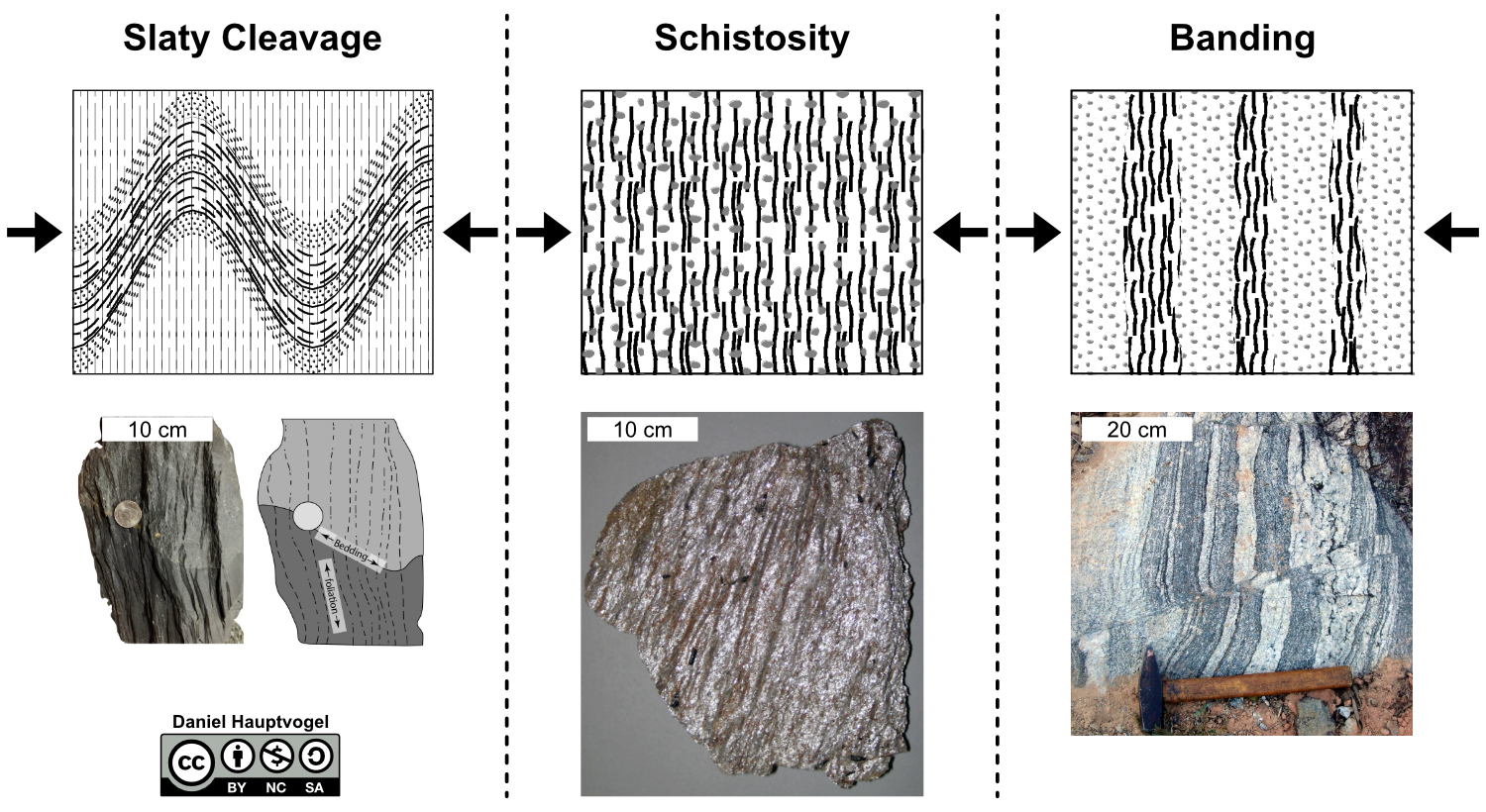
Exercise 8.2 – Observing Foliation
Your instructor will provide you with a set of rocks. Sort the rocks based on whether or not they have foliation (Table 8.1). Use Figure 8.1 to help.
| Foliation | Rock sample |
| Foliated | |
| Non-Foliated |
8.3 Index Minerals
In addition to the texture, geologists also use the composition to help interpret metamorphic rocks. Some of the common minerals you’ve learned about occur in metamorphic rocks, like quartz, feldspars, micas, but there are also many you haven’t learned about. Some minerals only occur in metamorphic rocks, and some only occur under very specific pressure and temperature conditions, called (index minerals). Common index minerals include chlorite, biotite, garnet, staurolite, kyanite, andalusite, and, sillimanite. There are over 75 metamorphic minerals. We don’t expect you to identify all of these. Do you remember the term polymorph from your lecture class? Andalusite, kyanite and sillimanite are all polymorphs of Al2SiO5 as they have different atomic structures. Some of these index minerals hard and so can be identified as bumps in the rock such as brown staurolite, reddish brown garnet, blue blades of kyanite, pinkish-white rectangles of andalusite, whitish needles of sillimanite, or pistacho green epidote. Some others are not as hard such as chlorite, a dark green mica, actinolite, a light green amphibole, and serpentine, a group of minerals that are slippery feeling and mottled green.
Exercise 8.3 – Identifying Minerals in Metamorphic Rocks
As a class, discuss the minerals in your metamorphic rocks. Your instructor may guide the discussion or select specific samples for you to look at.
- What are some of the common minerals in your rocks?
- Do any of your rocks contain index minerals? If so, what are they?
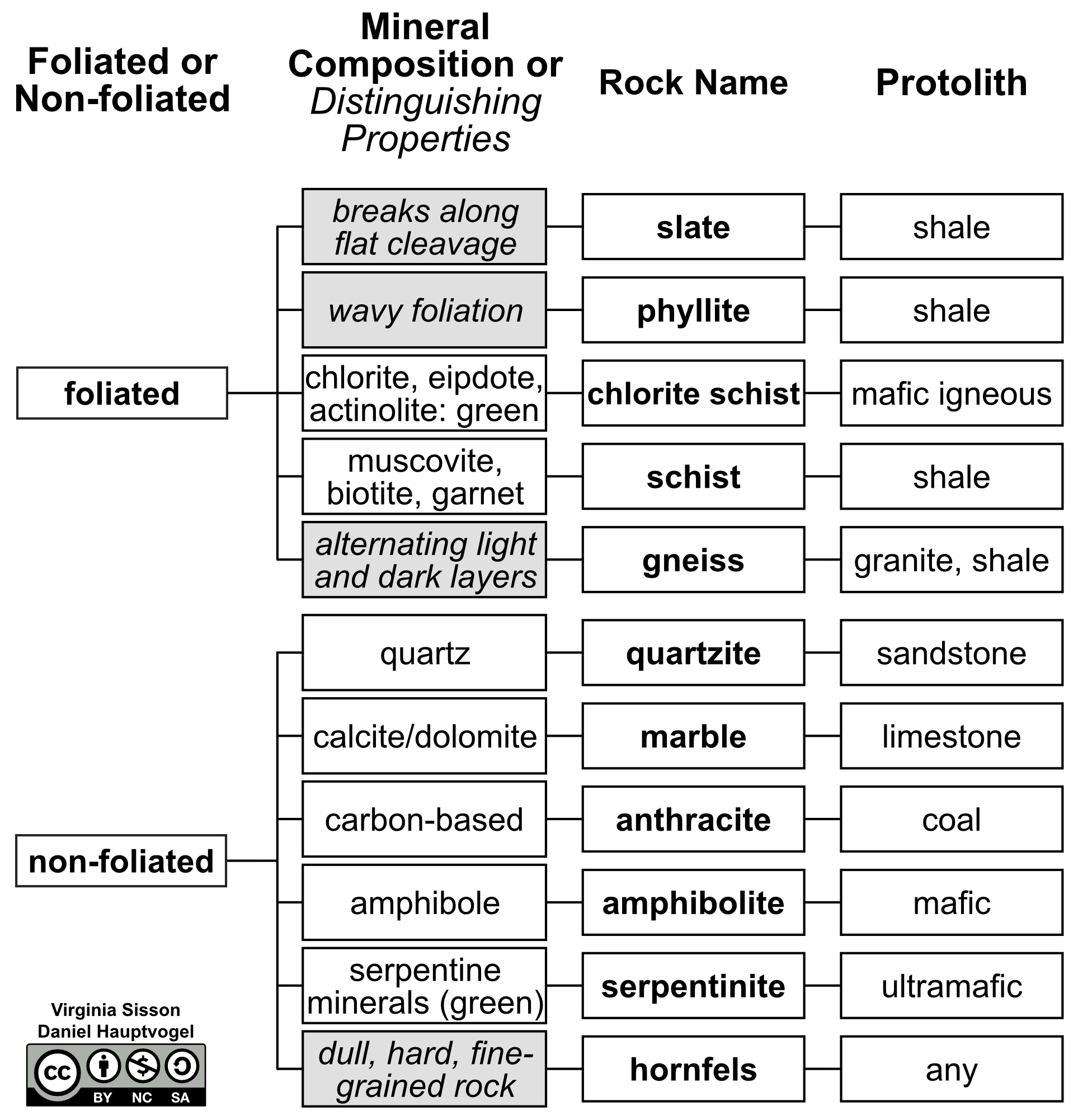
Exercise 8.4 – Identifying Metamorphic Rocks
Use the flow chart from Figure 8.2 to help you identify your metamorphic rocks and fill in Table 8.2. You’ve already looked at foliated vs. non-foliated and discussed the minerals.
| Sample | Foliated or Non-foliated | Minerals you can see | Rock Name |
|
|
|||
|
|
|||
|
|
|||
|
|
|||
|
|
|||
|
|
|||
|
|
|||
|
|
|||
|
|
|||
|
|
|||
|
|
|||
|
|
8.4 Metamorphic Grade and Protoliths
One more aspect of identifying metamorphic rocks is determining the maximum temperature that the rock reached. You can either use metamorphic grade or metamorphic facies. In this lab book, we will focus on relative metamorphic grade from low to high. Generally, the boundaries start with low grade metamorphism at temperatures of ~200 oC, then medium grade at ~425 oC, and finally high grade at ~600 oC (Figure 8.3). The boundaries are not exact as they depend on pressure and rock composition.
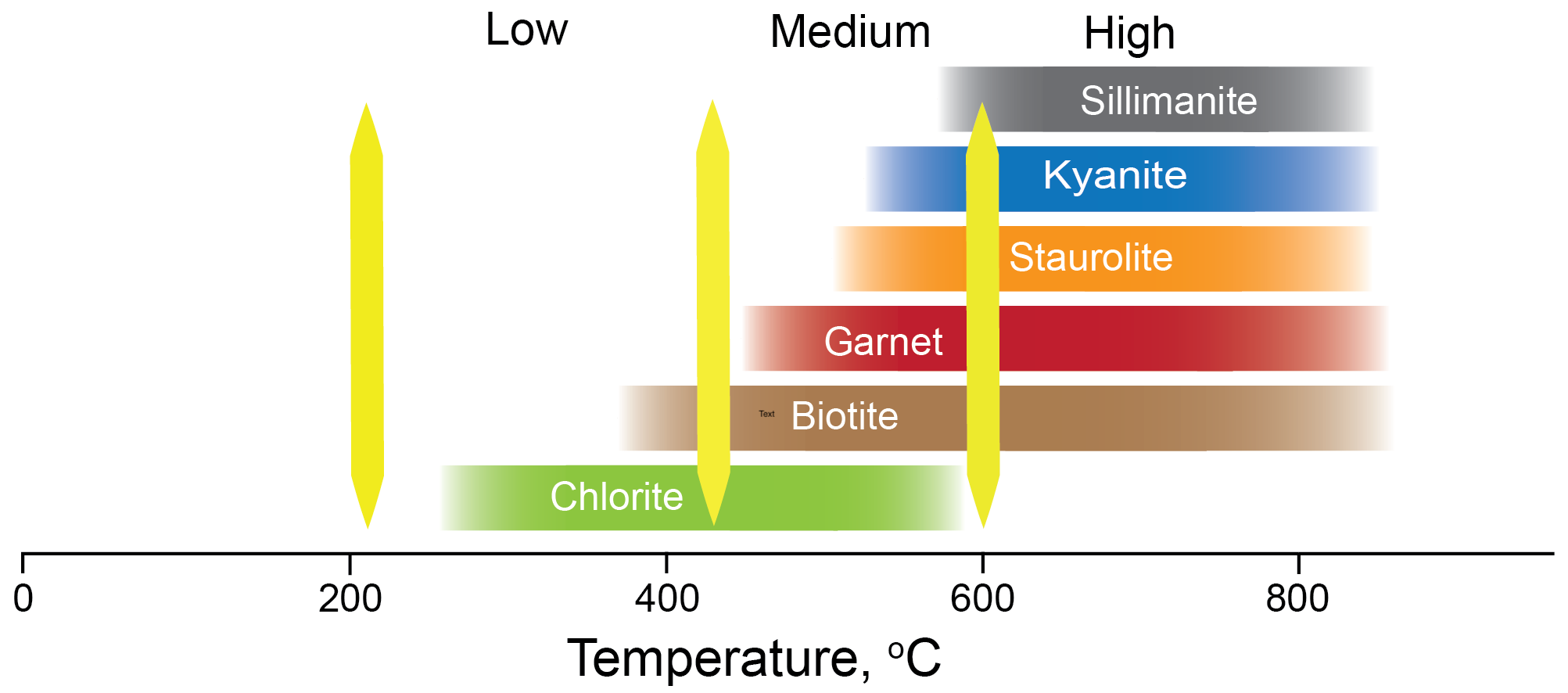
What a metamorphic rock was before metamorphism is called the protolith (Figure 8.4). In different tectonic settings, a variety of protolith types can be metamorphosed. These rocks will be exposed to the same range of pressure and temperatures conditions, however, the metamorphic rock that results will depend on the characteristics of the protolith.
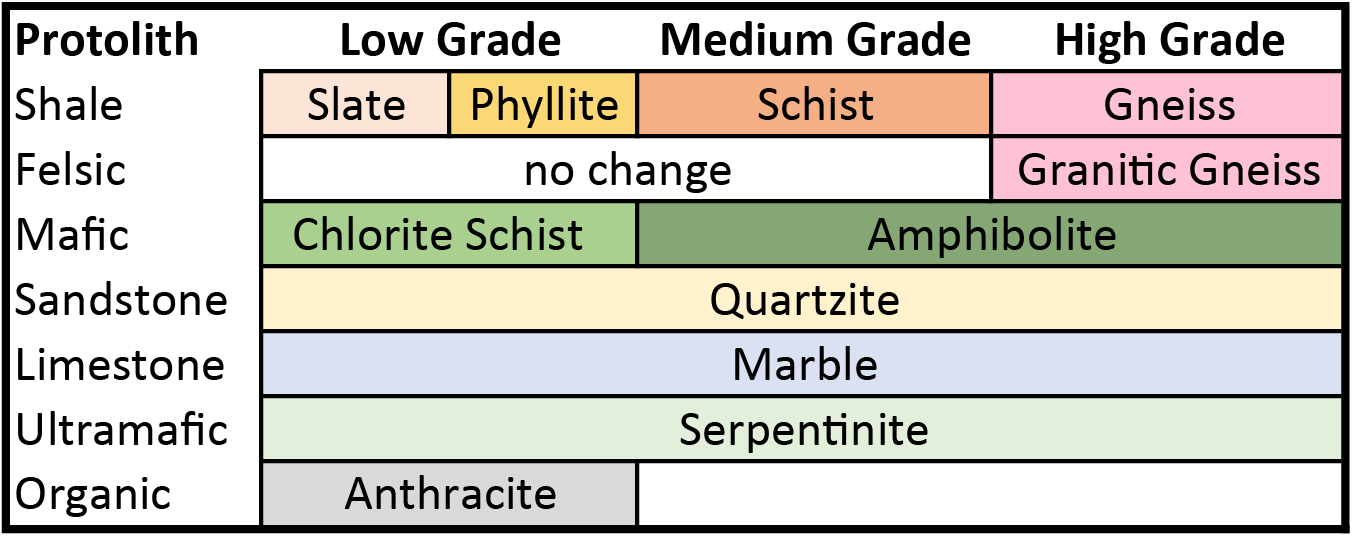
Exercise 8.5 – Understanding Metamorphic Grade
The most classic example of looking at metamorphic grade in rocks is in the Scottish Highlands where, in the late 19th and early 20th centuries, George Barrow mapped a large region of variable metamorphic grade. The map seen in Figure 8.5 is derived from Barrow’s work. He mapped different metamorphic zones based on the metamorphic minerals that were present. Each of Barrow’s zones is characterized by a particular index mineral that reflects metamorphic grade. Thus, the zone names in this map.
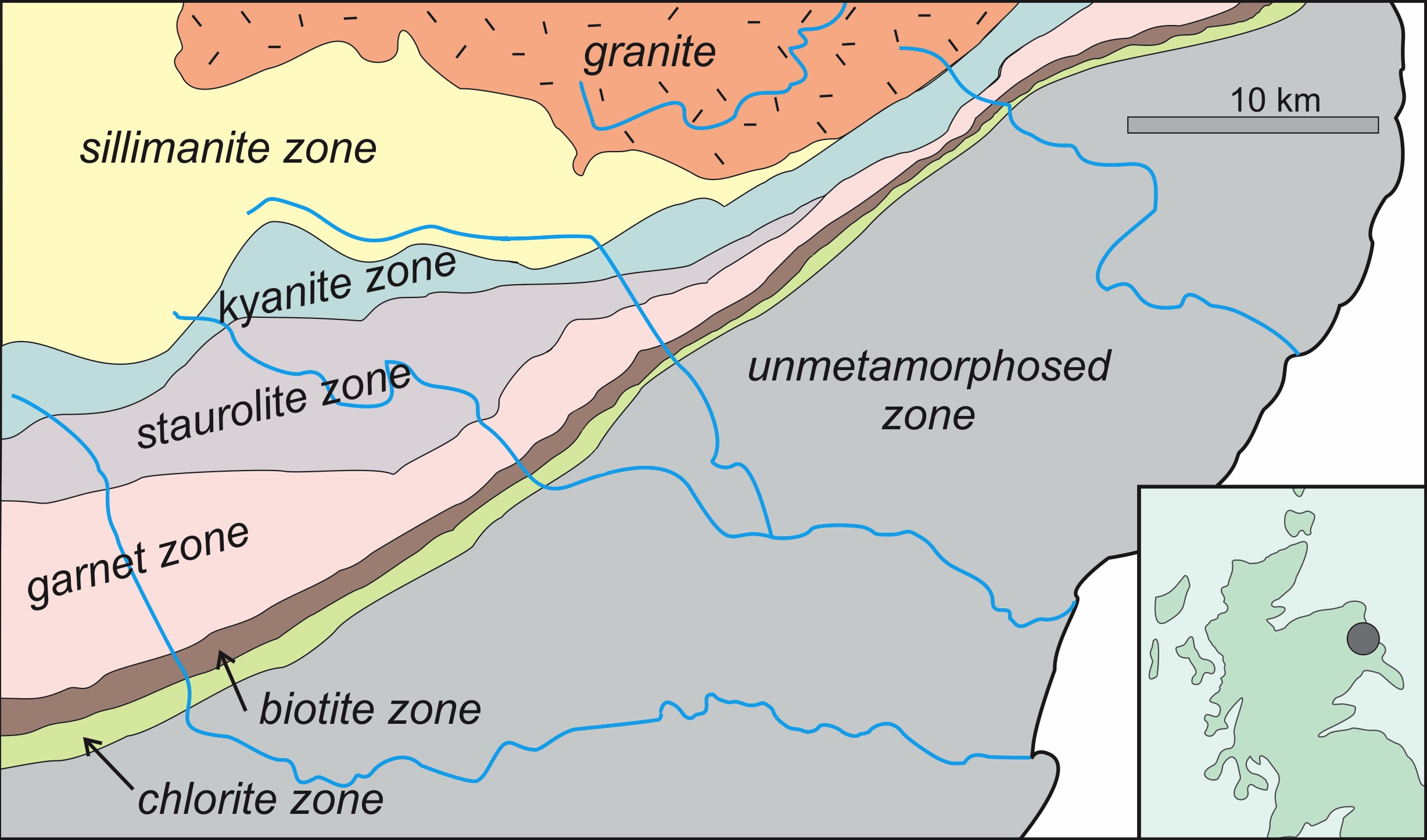
- On the map in Figure 8.5, drawn an arrow that shows the direction metamorphism increases.
- Based on the metamorphic zones, draw lines that represent the separation between low, medium, and high grade metamorphic rocks.
- Critical Thinking: Hypothesize how and when the granite at the top of the map formed.
- Using Figures 8.3 and 8.4, determine the relative grade of your metamorphic rocks in Table 8.3.
Table 8.3 – Minerals in your coarse-grained rocks Metamorphic Grade Rock Sample Numbers Low Medium High
Exercise 8.6 – Understanding Protoliths
Your instructor has given each of you a rock. Half of the class has metamorphic rocks, and the other half has protoliths.
- Which type of rock do you have and what’s its name? ____________________
- Now try to match up the metamorphic rocks with their protoliths. If you have a metamorphic rock, look for another student that has your protolith. If you have an igneous or sedimentary rock, find the rock that yours would turn into after metamorphism. Which rock did you pair up with and why?
- Identify the protolith for your metamorphic rocks in Table 8.4. Use Figure 8.4 to help.
Table 8.4 – Metamorphic rock identification Sample Rock Name Protolith
8.5 Mapping Metamorphic Rocks
You’ve already learned that geologic maps can help you determine physical processes and geologic history of a region. The same is true for metamorphic maps as they help you figure out the direction of change of pressure and temperature in a region (Figure 8.5). They also help you determine the tectonic setting of the region. Figure 8.6 shows a metamorphic map for three different protoliths surrounding an igneous granite.
In addition to figuring the direction of temperature increase, this map also shows how fluids and chemical elements may have moved during metamorphism. In this case, silica may have moved from the granite into the marble. This also happens when copper, iron, tungsten, and other elements are deposited in economic ore deposits around igneous rocks.
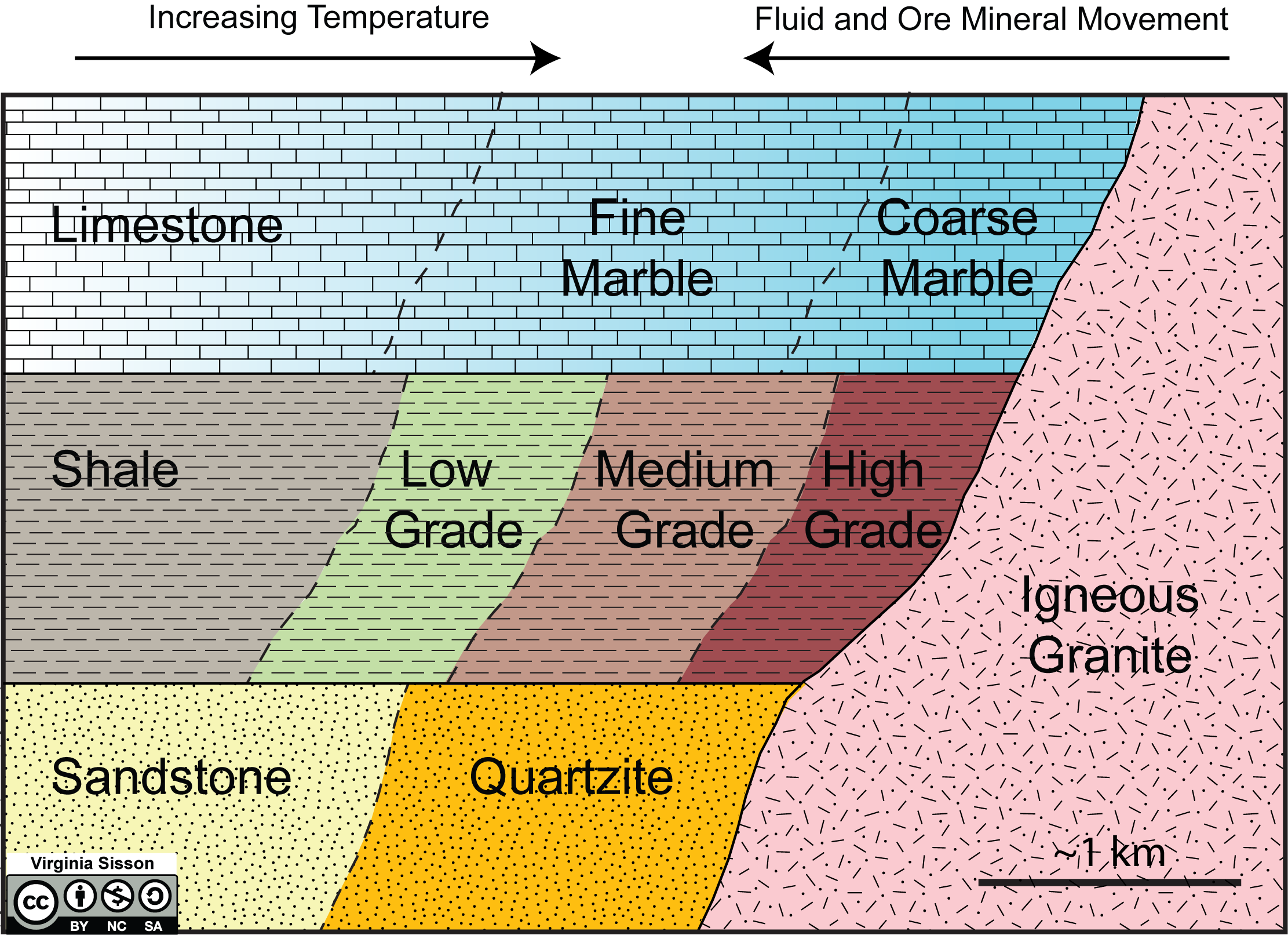
Exercise 8.7 – Creating a Metamorphic Map
One of the geology professors has found out where all the samples you looked at for this lab are found. She has mapped their locations and indicated them with a dot on the map provided by your instructor. Each location is marked with the number for the rock type found there.
To help understand this map, you need to distinguish two types of data: metamorphic grade or how hot the rock was at the peak of metamorphism, and the composition of the rock (called protolith). So, to interpret the metamorphic rock data, you will need to draw lines and color/shade different regions to interpret the geology.
Using a dashed line, draw isograds (lines of equal metamorphic grade) between low to medium and medium to high grade. You should end up with two parallel lines, but these can be at an angle to the edge of the map. This is because heat travels consistently in one direction through the Earth; so isograds are parallel lines with grade decreasing away from the heat source. Not all metamorphic rocks are useful for determining metamorphic grade, as the texture in granoblastic rocks does not change with temperature (see Figure 8.4). Also, rocks that only have one or two minerals, such as marble and quartzite, do not have any index minerals.
Drawing isograds or lines of equal metamorphic grade:
- Draw each line as a continuous curve between or around points. Do not use short lines or lines drawn with a ruler.
- Draw lines between all points of equal value.
- Extend your lines all the way to the edge of the box.
- Completely erase any mistakes or stray lines.
Next, draw solid lines between and around different rock compositions/protoliths. The different compositions you have looked at include organic, calcareous, shales, felsic (sandstone/granite), and mafic rocks. For simplicity, you can group the organic with the shales as organic matter is often deposited with shales in marshes.
Shading the composition (rock type or protoliths)
- Use colored pencils to shade the different rock protoliths.
- Include the colors in the legend/key on the side or bottom of the map.
- Press lightly with your colored pencil using the side of the pencil and not the tip.
- Hold the pencil toward the back/end of the pencil, far away from the tip.
- Apply pressure evenly the entire time you are shading the rock protolith.
- Move the pencil back and forth in the same direction across the entire page (do not shade up-down in one section and left-right in another section.
- Completely shade the entire area – leave no area uncolored.
Next, lightly shade the area for each composition. A suggested color scheme is green = mafic, blue = calcareous (limestone), and yellow = felsic/shale/organic. The boundaries between the protoliths can be as small bodies shown as elongated lenses (not circles) or extend across the entire map.
After you have completed your map, answer these questions.
- Is this regional or contact metamorphism? Hint: look at the rock fabric and the scale of the map.
- Now that you have determined if this is regional or contact metamorphism, what do you think was the tectonic setting? Explain.
- Often, geologists want to know the geothermal gradient in a region. Use Figure 8.3 in to determine the temperature for each grade. What is the temperature range for this region? ____________________
- Next, divide the temperature range by the distance to get the horizontal geothermal gradient across your map. ____________________
8.6 Mineral Stability and Assemblages
Investigating metamorphic rocks is like being a detective to determine how deep and how hot rocks have been. Geoscientists call this geothermobarometry. One of the tools used to determine these variables are petrogenitic grids (Figure 8.7). These are x-y plots for the stability ranges of metamorphic minerals and mineral assemblages. The first petrogenitic grids were constructed by Bowen in the 1940 using experimentally determined mineral stability ranges that are plotted as metamorphic reaction boundaries to produce a petrogenetic grid for a particular rock composition. The regions of overlap of the stability fields of minerals form equilibrium mineral assemblages used to determine the pressure–temperature conditions of metamorphism.
Exercise 8.8 – Pressure and Temperature in Metamorphism
Geologists like numbers. For metamorphic rocks, the two most important numbers are the temperature that it formed at as well as the pressure. These are related by metamorphic reactions (lines on Figure 8.7). There are several types of metamorphic reactions. Some involve dehydration (loss of OH– ions), others are solid-state reactions such as polymorphic transitions, and others involve hydration (addition of OH– ions). On Figure 8.7, there are many metamorphic reactions shown by lines across the pressure-temperature grid. These are generally written with the reactants on the left side and the products on the right side. This is true for all reactions that are relatively vertical on this diagram.
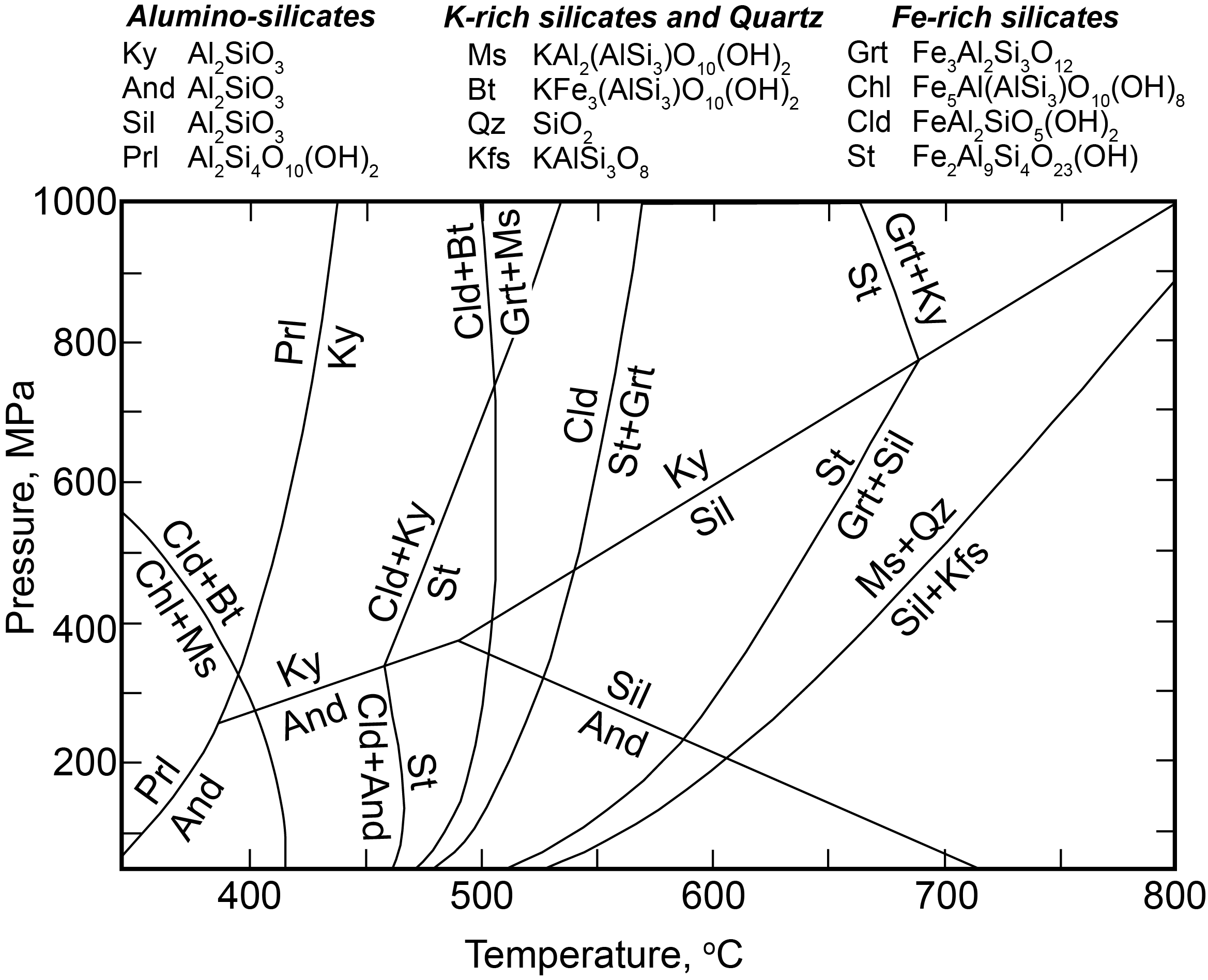
| Abbreviation | Mineral | Chemical Formula |
| Ky | Kyanite | Al2SiO5 |
| And | Andalusite | Al2SiO5 |
| Sil | Sillimanite | Al2SiO5 |
| Prl | Pyrophyllite | Al2Si4O10(OH)2 |
| Ms | Muscovite | KAl2(AlSi3)O10(OH)2 |
| Bt | Biotite | KFe3(AlSi3)O10(OH)2 |
| Grt | Garnet | Fe3Al2Si3O12 |
| Chl | Chlorite | Fe5Al(AlSi3)O10(OH)8 |
| Cld | Chloritoid | FeAl2SiO5(OH)2 |
| St | Staurolite | Fe2Al9Si4O23(OH) |
| Qz | Quartz | SiO2 |
| Kfs | K-feldspar | KAlSi3O8 |
- Identify one solid state (polymorphic) reaction (chemical formula remains the same). ____________________
- Is the slope of this line steep or shallow? ____________________
- Identify one reaction that involves loss of water (dehydration) seen as a change in OH from products to reactants. ____________________
- Is the slope of this line steep or shallow? ____________________
- What can you conclude about what happens to water (OH) during metamorphism?
- Low grade slates contain a dark green mica, chlorite. Those with a brownish color contain biotite. On Figure 8.7, color the area where rocks would contain chlorite and lack biotite. This would be the pressure-temperature conditions for slate.
- In a different color, color the area where rocks contain biotite but not garnet. This would be a phyllite.
- In a third color, color the area where rocks contain garnet and muscovite. This would the pressure and temperatures for a schist.
- Give the range of temperature and pressure conditions for slate, phyllite, and schist.
- Slate: ___________________
- Phyllite: ____________________
- Schist: ____________________
- To better constrain the pressure that these rocks formed at, you need some other mineral species in your samples. In most regionally metamorphic terrains, this is kyanite. If the rocks you are investigating have kyanite, at what pressure did they form? Explain.
- In the Central Texas region, especially near Inks Lake State Park, you can find sillimanite and muscovite in schist and gneissic rocks with no K-feldspar. What is the range of pressure that these rocks could occur at? ____________________
- Critical Thinking: In some regions, there are changes in the alumino-silicates (Ky, Sil, and And) with metamorphic grade. We can use these to find changes in pressure. So, if your phyllite has andalusite and your schist has kyanite, what probably happened to the pressure during metamorphism. What type of tectonic setting would this probably be?
Additional Information
Exercise Contributions
Virginia Sisson and Daniel Hauptvogel
References
Bowen, Norman (1940) Progressive Metamorphism of Siliceous Limestone and Dolomite. The Journal of Geology. 48: 225–274. doi:10.1086/624885
Spear FS, Cheney JT (1989) A petrogenetic grid for pelitic schists in the system SiO2-Al2O3-FeO-MgO-K2O-H2O. Contributions to Mineralogy and Petrology 101: 149-164. https://doi.org/10.1007/BF00375302
the increase in temperature with depth in the Earth
repetitive layering in metamorphic rocks. Each layer can be as thin as a sheet of paper, or over a meter in thickness.
cleavage is a type of foliation that forms within fine grained rocks due to deformation and metamorphism
a type of foliation developed in medium grained metamorphic rocks, often in mica-rich rocks
a mineral that forms under specific pressure and temperature conditions, and provides information about the rock's metamorphic history. Examples include kyanite, garnet, etc.
a chemical composition can crystallize in more than one form. This occurs in response to changes in temperature or pressure or both. Common examples are carbon which occurs graphite, diamond and buckminsterfullerene. Another example is calcium carbonate which occurs as calcite or aragonite.
a rock that existed before it gets metamorphosed, also called parent rock
the science of measuring the pressure and temperature history of a metamorphic or intrusive igneous rocks. This term is a combination of geobarometry, where a pressure of mineral formation is resolved, and geothermometry where a temperature of formation is resolved.
a geological phase diagram that connects the stability ranges of metamorphic minerals or mineral assemblages using metamorphic reactions
a metamorphic rock with a shale protolith

